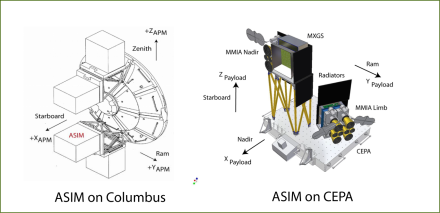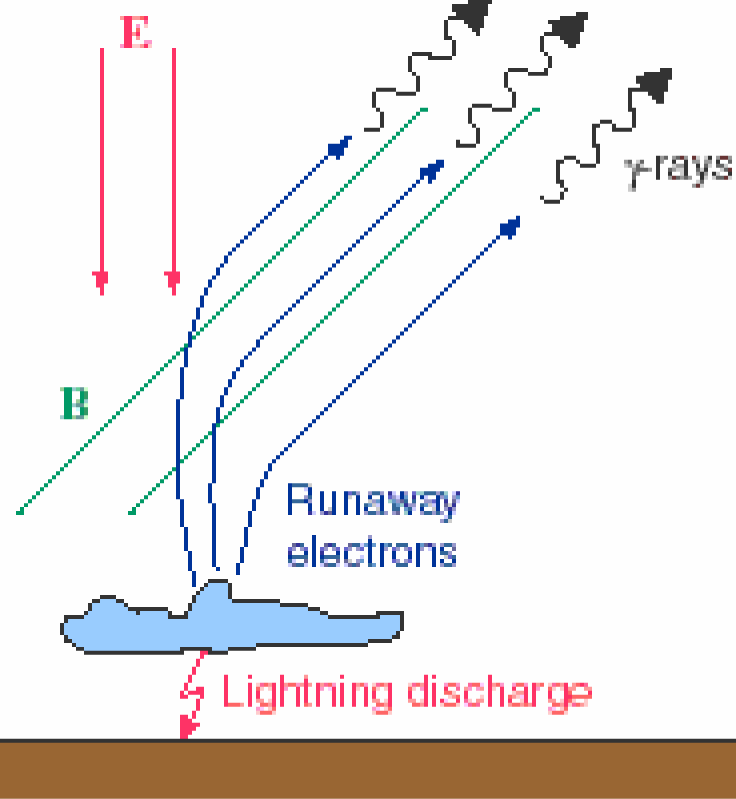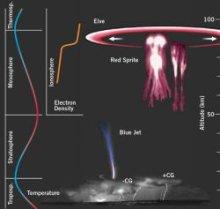ASIM research
The most common Transient Luminous Events (TLE) are Red Sprites, Blue Jets and Elves. These are optical phenomena that can be studied in visible and ultraviolet wavelengths and are observed above thunderstorms.
Main content
The Terrestrial Gamma Flashes (TGF) are probably related to TLE and/or thunderstorms. The TGF were discovered in 1994 by the BATSE instrument (Fishman et al., 1994). TGFs are X-ray bremssthrahlung produced by relativistic electrons, up to tens of MeVs (Smith et al., 2005), on their way out of the atmosphere.
To see how a red sprite evolves, you can look at this MOVIE taken with a 1000 frames pr sec or this MOVIE taken with a 10.000 frames pr sec. In the latter you can see the streamer head that forms the sprite tendrils. Courtesy to Prof. Hans C. S. Nielsen, Geophysical Institute, University of Alaska Fairbanks.
Both TLEs and TGFs are related to thunderstorm regions, but exactly how and if TLEs and TGFs are inter-related, are still not know. The global frequency of lightening is about 45 pr. sec, while TLEs and TGFs are 5.5 pr min and 4 pr. hour, respectively. The most active thunderstorm regions are over the main land at low latitudes. The ISS is therefore one of the best platform available in space for observations of TLEs and TGFs, placed in the lowest available orbit (~350 km) at an inclination (55 degrees) that covers all thunderstorm regions and all local times.
The main scientific goals of ASIM (Neubert et al., 2006) are to:
- Provide the most comprehensive survey to date of the occurrences of TLEs and TGFs on a global scale
- Study the physics of TGFs and their relationship with TLEs.
- Study the physics of TLEs
- Determine the characteristics that make thunderstorms TLE- and TGF-active.
- Study the coupling to the ionosphere of thunderstorms and TLEs
- Study the effects of thunderstorms and TGFs on the Earth's radiation belts.
Secondary science objectives include
- Auroral studies
- Studies of greenhouse gas consentration above thunderstorms (NOx, O3)
- Studies of meteor ablation in the mesosphere and thermosphere
The ASIM payload consists of six optical imagers, six UV photometers, and one X- and gamma-ray detector (red in the figure below). A sketch of the payload on the lower starboard of the Columbus module are shown below
The MXGS to observe TGF
The University of Bergen is involved in the miniature X-ray and gamma sensor (MXGS), which will be optimized to detect occurrence frequency of TGFs and obtain spectral characteristics at the highest time resolution as possible. Due to the absorption and Comptong scattering of X-rays on their way out of the atmosphere it is possible to infer the peak production altitude from the X-ray spectra. This is crucial to understand the production mechanism of TGFs.
Scientist are welcome onboard
At the moment the Norwegian science team involves researchers from the Space Physics Group at the University of Bergen and the Norwegian Institute for Air Research (NILU), but the project is open for researchers from other Institutes and Research Centers in Norway.
For more information, please contact Prof. Nikolai Østgaard .
References
Fishman, G. J., P. N. Baht, R. Mallozzi, J. M. Horack, T. Koshut, C. Kouveliotou, G. N. Pendleton, C. A. Meegan, R. B. Wilson, W. S. Paciesas, S. J. Goodman, and H. J. Christian, Discovery of intense gamma-ray flashes of atmospheric origin, Science, 164, 1313, 1994.
Smith, D.M., L.I.Lopez, R.Lin and C. P. Barrington-Leigh, Science, Vol 307, 2005



